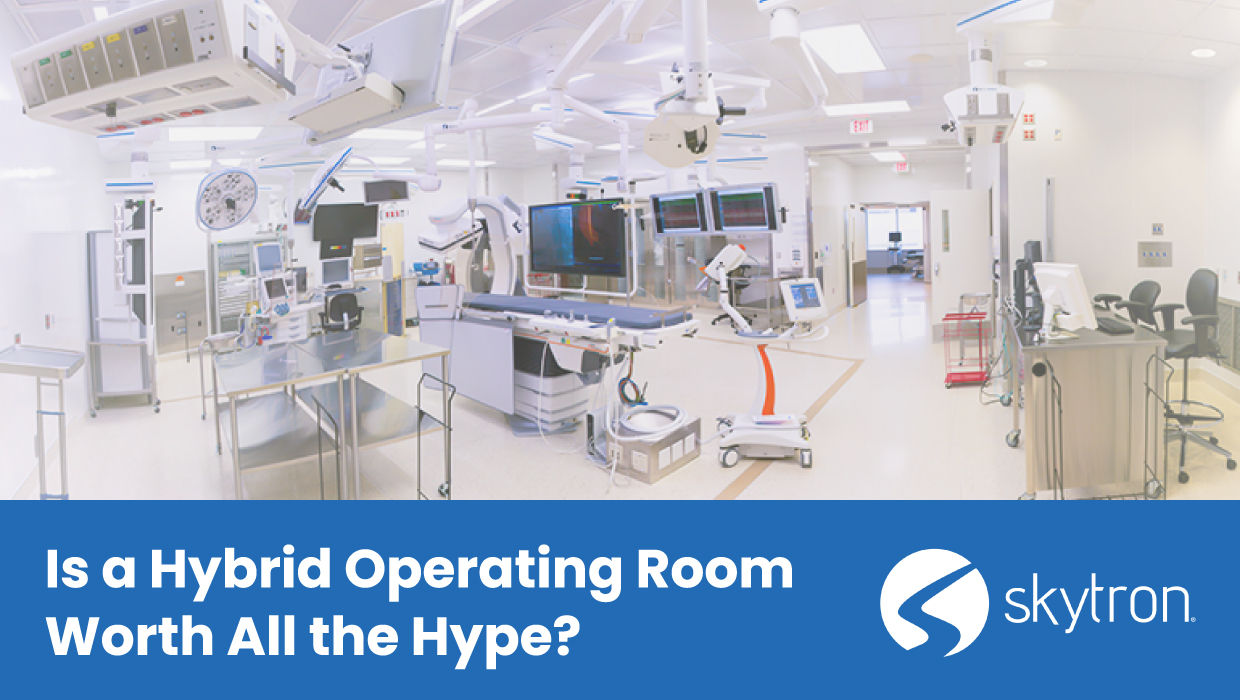
-
Written ByRebecca Kinney
-
PublishedJuly 30, 2024
With the combination of surgical facilities and imaging systems in one room, hybrid ORs can be used for traditional open surgeries, image-guided surgeries, or a combination of procedure types, offering greater flexibility and utility of the space.2
Building a hybrid operating room (HOR) is a hefty investment for any hospital or ambulatory surgery center. Definitive Health says, “Investing in a modern surgical suite can cost upward of $5 million. The construction of the room itself – with stainless steel walls, antimicrobial flooring, and facility renovation costs – runs about $2 million.”1 The cost alone is worthy of making any decision maker of a new facility or surgery center recoil and beg to go the traditional operating room route. That said, a HOR comes with multiple benefits you may not have considered. In this write-up, we want to review a few of them and the history of how the HOR began.
What is a hybrid operating room?
A hybrid operating room (OR) combines the capabilities of an operating room with the technologies of interventional imaging. With the combination of surgical facilities and imaging systems in one room, hybrid ORs can be used for traditional open surgeries, image-guided surgeries, or a combination of procedure types, offering greater flexibility and utility of the space.2
Surgical specialties that benefit from HORs include, but are not limited to:
- Cardiovascular
Abdominal aortic aneurysm repair, aortic stent grafting, carotid stent grafting, endovascular aortic repair (EVAR), and thoracic endovascular aortic repair (TEVAR). -
Cardiothoracic
Minimally invasive endoscopic bypass surgery, robotically enhanced minimally invasive direct coronary artery bypass, minimally invasive direct coronary artery bypass grafting, atrial fibrillation/flutter ablation, and more. - Neurovascular
Micro neurosurgical resection of brain tumors, cerebral balloon angioplasty, coil embolization, or microsurgical clipping of cerebral aneurysms, cerebral and spinal vascular tumors, and more. - Other Surgical Areas
Hemorrhage control in trauma patients, high-risk obstetrics, and orthopedic trauma
HORs are typically characterized by the type of imaging equipment installed in the room and the clinical services offered. They can be found in cath labs, interventional imaging suites, and surgical suites.
A brief history & additional facts
The initial drive for hybrid operating rooms emerged about twenty years ago with the advent of radiology techniques. Rather than have radiology in a separate room, which was previously the norm, hospitals decided to do it right where the surgery takes place (for live monitoring).
Another factor in the rise of hybrid ORs was the increasing difficulty for hospital administrators to justify specialized rooms. They were costly to maintain and cumbersome to manage. Plus, they had varying rates of utilization. Some were occupied up to 10 hours/day while others remained idle for hours at a time.
“Part of the reason hybrid ORs have taken center stage in operating room design is their effectiveness in tackling the entire gamut of surgical requirements.” 3
A HOR is determined on a case-by-case basis. Many hospitals have medical specialties. The Cleveland Clinic, for example, has a strong cardiac program4, so a hybrid OR will likely focus more on cardiac procedures. Similarly, hospitals specializing in neurosurgery will retrofit their hybrid ORs to be more suited for delicate neuro treatment, and so on.
Benefits
A few benefits of having a HOR at your facility include:
Enhanced Versatility: When you combine the capabilities of the OR with imagining the same place, you can do more for your patient in one location. This can be particularly helpful with highly volatile or trauma patients. Skytron focuses on efficiency as a focal point when helping you develop your HOR.
Improved Patient Outcomes: The ability to perform complex procedures with advanced imaging in real-time can lead to better precision and fewer complications creating a safer environment for your patients.
Reduced Procedure Time: Procedures can be completed more efficiently, reducing the overall time spent in surgery. Time is money, especially in our ORs!
Increased Safety: Minimizing patient transfers between different rooms reduces the risk of infection and other complications.
Cost Efficiency: Although the initial setup cost is high, the efficiency and reduced need for multiple procedures can lower overall healthcare costs.
Collaboration Opportunities: The integrated environment fosters better teamwork among multidisciplinary medical teams, enhancing the overall quality of care.
If you asked us, is a HOR worth all the hype and the investment? We would give a resounding YES without a doubt. Better earning capabilities for your facility, better patient outcomes, and more efficiency. What’s not to love?
Resources
1. How hybrid operating rooms are changing inpatient care | Definitive Healthcase
2. Hybrid Operating Room Design Basics | Facility Guidelines Institute™
3. An Overview of Hybrid Operating Rooms | BFW, Inc
4. Cleveland Clinic Remains Nation’s No. 1 Hospital for Heart Care, in U.S. News & World Report’s 2022-23 Best Hospitals Rankings | Cleveland Clinic






